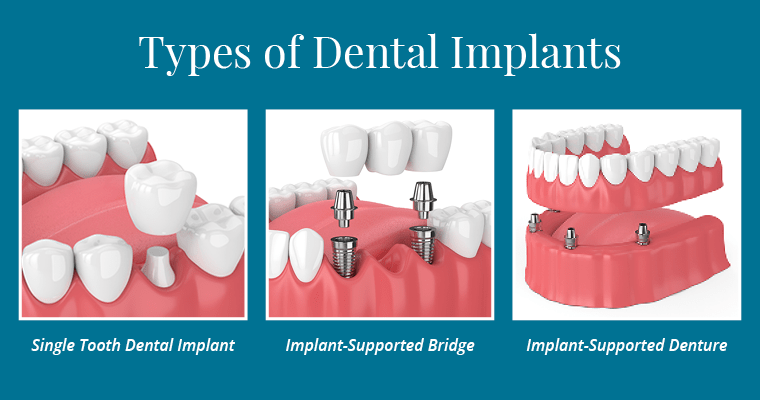The Buzz on Dental Implants
The Buzz on Dental Implants
Blog Article
Dental Implants for Dummies
Table of ContentsThe smart Trick of Dental Implants That Nobody is DiscussingThe Main Principles Of Dental Implants Dental Implants Fundamentals Explained6 Simple Techniques For Dental Implants
are medical gadgets operatively implanted right into the jaw to bring back an individual's capability to eat or their look. They offer support for fabricated (fake) teeth, such as crowns, bridges, or dentures. When a tooth is lost as a result of injury or disease, a person can experience difficulties such as fast bone loss, faulty speech, or adjustments to eating patterns that result in pain.
Structure of The Dental Implant System selecting oral implants, speak with your oral provider about the possible advantages and threats, and whether you are a prospect for the procedure. Things to take into consideration: Your overall health and wellness is an essential consider identifying whether you are a great prospect for dental implants, the length of time it will certainly require to recover, and the length of time the implant might remain in area.
Smoking cigarettes may influence the recovery procedure and lower the long-term success of the implant. The recovery procedure for the dental implant body might take several months or longer, throughout which time you generally have a short-term abutment in place of the tooth. the oral implant treatment: Thoroughly comply with the oral health instructions provided to you by your dental provider.
The Basic Principles Of Dental Implants
Implant failure can result in the requirement for one more surgery to repair or change the dental implant system. Brings back the capacity to eat Brings back cosmetic appearance Aids maintain the jawbone from shrinking as a result of bone loss Preserves the health and wellness of the bordering bone and periodontals Helps maintain surrounding (nearby) teeth steady Boosts lifestyle Damage to bordering all-natural teeth during implant placement Injury to the surrounding tissues during surgical procedure, such as sinus perforation Injury throughout surgery (for instance, fracture of bordering jawbone) Inadequate feature, such as seeming like the teeth do not bite with each other usually An experience that the tooth hangs or turning in place arising from an abutment screw loosening Implant body failure (looseness of the dental implant body) because of systemic infection, which may be more probable in clients with unchecked diabetics issues because of local infection in bone and gum tissues sustaining the click now implant body as a result of delayed healing, which may be much more likely in patients webpage that smoke Trouble cleaning the gum tissues around the implant, leading to poor oral health Untreated periodontal illness Post-surgical pins and needles due to nerve impingement or damage Constantly alert health care providers and imaging specialists that you have oral implants before any kind of magnetic vibration imaging (MRI) or x-ray procedures.
FDA is not knowledgeable about any damaging occasions reported for MRI or x-ray treatments with dental implants. Dental implants systems are generally constructed from products that comply with global consensus criteria of the International Company for Standardization (ISO) or ASTM International. These criteria have details of what makes a safe product.
Dental dental implant systems are evaluated according to global agreement Extra resources standards. Biocompatibility testing, to reveal that bodily contact with the tool does not trigger issues like irritation or allergic reaction, is part of the assessment that helps ensure the materials in the oral implant system are risk-free and do not trigger unfavorable results when implanted in individuals.

Dental Implants for Dummies
Some individuals are not eligible for oral implant surgery. It is for dental cosmetic surgeons to operate on people with: intense illnessuncontrollable metabolic diseasebone or soft cells disease or infectionIf these issues are fixed, an individual can have the surgical procedure. Dental Implants. In, oral surgeons refrain from operating people with: If people with any of the above undergo oral implant surgery, there is a higher risk of the dental implant falling short
Some individuals have a jawbone abnormality that protects against sufficient bone for a dental implant from developing. The cosmetic surgeon will certainly then use a bone or bone replacement to fix and build up the location.
Dental implant surgery is a personalized process. It's not the very same for everybody. But the following gives a general review of what you can anticipate your dental expert, oral cosmetic surgeon, periodontist or prosthodontist to do: Put the dental implant surgically. Give you time to recover. Affix the post and last crown, bridge or denture.
Next off, your specialist will thoroughly put the dental implant into your jaw. Your specialist will rearrange your gums and shut the incision with stitches (Dental Implants). If your dental implant is near the front of your mouth, your dentist will make a temporary tooth for you to put on up until you heal. In this way, you won't have a space in your smile while you recoup.
A Biased View of Dental Implants
Your supplier can inform you what to expect in your scenario. During the healing phase, your jawbone must fuse to the oral implant. This procedure, called osseointegration, is important for security and long-lasting success. This procedure can take anywhere from three to 9 months. Sometimes, it might take longer.
Once your dental implant heals, your dental expert can affix the joint (tiny adapter article) and your final repair (crown, bridge or denture). This normally takes concerning one hour to finish and might need a 2nd minor surgical procedure. You should not feel any discomfort during your oral implant procedure since your provider will utilize medicine to numb your gum tissues.
Report this page